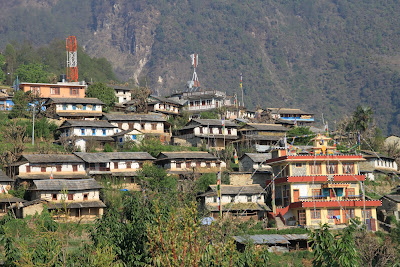The trek began from Pokhara, the city of the beautiful Phewa Lake, which I write about in “A Little Taste of Heaven.” After an early morning flight from Kathmandu, two sherpas, met me at the airport and we began the journey into the Annapurnas. As we started the journey, the Sherpa serving as a porter ran ahead of us with ease as he carried the weight of our entire supplies and personal belongings for the next three days. While not a long period, so the supplies were limited, it was still a heavy load, and I was in awe of the weight that the sherpas have been accustomed to carrying on their shoulders and backs for generations- as much as 500 kilos! We trekked along the Seti Gandaki river for several kilometers before beginning the high ascent into the more mountainous terrain through remote villages amidst lush greenery and the rhododendrons that adorn the trekking route to Ghandruk.

Flowing waters of the Seti Gandaki

Mules bringing supplies into the remote villages of the Himalayas


Grazing mule along the river banks
Himalayan village
The views from Landruk and Ghandruk over the course of the three day trek were overwhelmingly breathtaking, and I feel blessed to have been so close to some of the highest, monumental peaks in this world. The Annapurna range is crowned by the Machhapuchhre twin peaks (meaning ‘fishtail’) and studded for miles with other captivating snow-capped peaks overlooking the tribal villages laced with the Nepali prayer flags.
 View of Annapurna range from my Landruk guesthouse
View of Annapurna range from my Landruk guesthouse 
A closer view of the Annapurnas

Even closer...you can't get enough of this beauty!


The morning before my first field visit to Bihar with the Grameen Foundation, I caught a Buddha Air flight that takes a small number of passengers along the Himalayan range up to the renowned Mount Everest before making a full circle back to Kathmandu. While it by no means compares to seeing Everest from its base camp, one can’t help but feel awestruck by the sight of it, even from the cockpit of the plane. The Himalayas, meaning “abode of snow” in Sanskrit, conjures all sorts of magical images in our minds and continues to profoundly shape the many colorful cultures of South Asia and beyond. It is the mother of several sacred rivers flowing through the Asian continent from Tajikistan to Vietnam and will forever be honored as such in our hearts.


Everest in the distance

Goodbye for now. I will be back.



Great post, Luckshmi, an amazing reflection of a memorable trip! Do hope you get back one day.
ReplyDelete